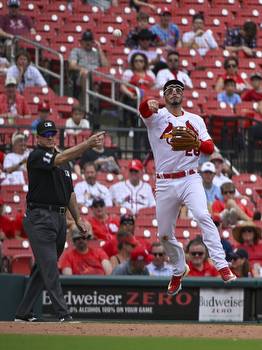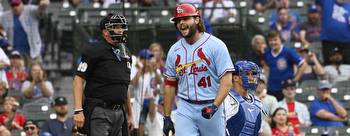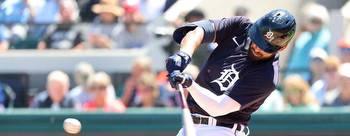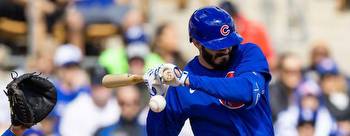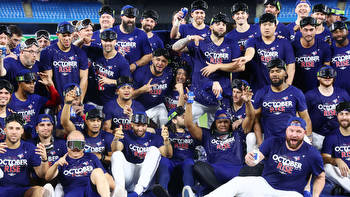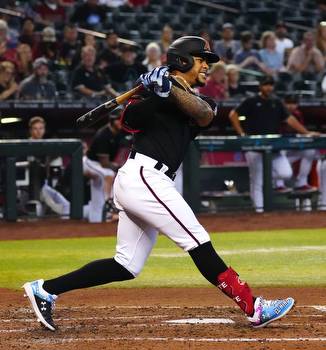An Optimistic Win Projection for the Diamondbacks
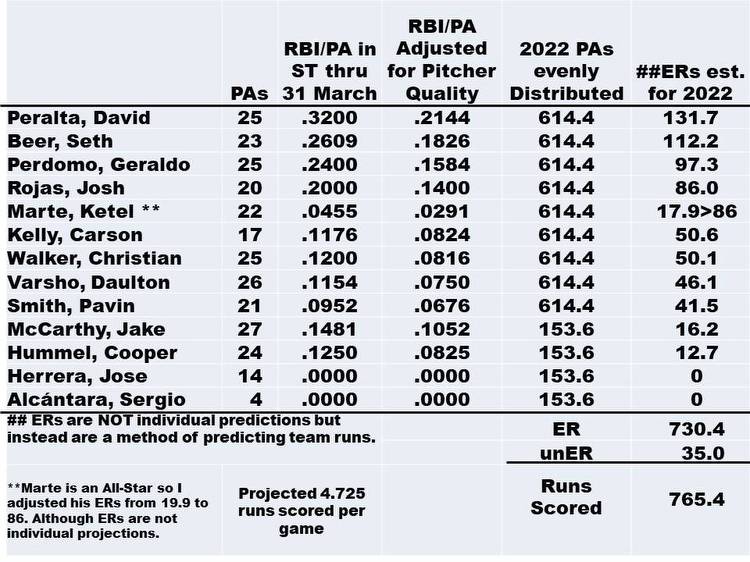
This article was written to provide explanations of my prediction of Diamondbacks wins this season. My prediction was included as one of many in Jim McLennan’s yearly set of AZ Snake Pit predictions.
As you may know my view is usually optimistic. Nevertheless, I kept an open mind, strived for an objective process, and was prepared to surprise myself.
General Approach.
My first steps were to predict runs scored and predict runs allowed. Then the Pythagorean theorem was used to calculate wins. However, the Diamondbacks consistently win less games than the theorem calculates, so the final prediction was reduced.
Roster Assumptions.
On 2 April, I made roster assumptions. Roster changes could impact the prediction for better or worse.
UPDATE on 6 April: Two big roster changes happened after my prediction - Josh Rojas was injured, Luke Weaver and Caleb Smith switched places between the rotation and the bullpen. If I assume 10 less runs scored and the pitching switch is a wash, that would reduce my prediction 1 win. Note that my estimate does not include their possible impact.
Runs Scored Assumptions.
This season, spring training provided an objective basis to predict runs scored. RBIs per plate appearance for nine go-to players in the batting lineup and four bench players were key data which was aggregated to predict runs scored.
The quality of pitchers faced was provided by Baseball Reference so that results were adjusted to the MLB level and aggregated to become a realistic estimate of the total runs by the team for the season, albeit that due small sample sizes estimates for individual batters would not be reliable.
For the purposes of the prediction, I separated runs earned by RBIs and unearned runs, with the assumption that unearned runs would be the same as last season. I looked back at several seasons and determined that was a reasonable assumption.
Despite my intention to keep the process objective, I increased the run contribution by Ketel Marte because it was unrealistically low. Eventually, I intend to investigate why his total RBIs were so low in spring training.
Runs Allowed Assumptions.
The spring training data for pitchers did not support the same process as the batters. Six of the key pitchers allowed zero earned runs through 31 March, with five of the six having faced less than ten batters.
The data for earned runs allowed per batter faced for 2021 was the key data. This data may have understated the quality of the Diamondbacks pitching because Brent Strom will certainly have a positive impact on at least a few of the Diamondbacks pitchers. Perhaps injuries during the season will have a negative impact that balances Brent Strom’s positive impact.
Similar to batters, I separated earned runs and unearned runs.
In the prediction table, some of the relievers will move back and forth between the Majors and the minors. For example, Tyler Gilbert and Taylor Widener were optioned to AAA Reno. The listed relievers are a representative bunch, some may be injured and some may be replaced with a better pitcher so hopefully the changes are neutral on balance.
In the prediction table, although Dan Straily is shown with the same number of batters faced as relievers, instead it’s likely he will be starting games during part of the season. During the season it’s likely that the Diamondbacks use 7 or 8 starters, which could impact the accuracy of the prediction, more so if the Diamondbacks use more than 8 starters.
The Prediction.
The following table shows the calculation that the Diamondbacks will score 765 runs this season. That achievable prediction would be 86 more runs than last season.
In spring training David Peralta had 8 RBIs in 25 PAs - truly amazing. While NOT predicting he gets 131.7 RBIs, it’s fair to say his batting is great! When the Diamondbacks are successful getting runners on base ahead of him, his RBIs may break out to a career high!
The following table shows the calculation that the Diamondbacks will allow 737 runs this season. That achievable prediction would be 67 less earned runs (and 54 less unearned runs) than last season.
The Pythagorean calculation is 83.76 wins. However, the Diamondbacks consistently win less games than the theorem calculation, so 3.6 wins were subtracted to reach my prediction, which rounded to 80 wins. That 3.6 win subtraction was the same subtraction that I made in last season’s prediction.
How does the prediction differ from the 2021 results?
Three big differences follow:
- 6 additional wins due to better defense. Last season the Diamondbacks had an uncharacteristically high unearned runs allowed. This season’s prediction assumes that better defense reduces unearned runs from 89 to 35.
- 6 additional wins from better hitting. Spring training was very encouraging. The Diamondbacks scored 3 or more runs in 14 of 18 games, and they scored 5 or more runs in 12 of 18 games. If they can continue to score that many runs in two thirds of their games during the regular season, my win prediction will have been pessimistic.
- 16 additional wins from better pitching. With Ian Kennedy as eighth inning setup guy and Mark Melancon as closer, the Diamondbacks will win a lot more close games. In addition, the impact of Brent Strom will be huge.
Summary.
This season, I predict the Diamondbacks will score 765 runs, they will allow 737 runs, and they will win 80 games.











